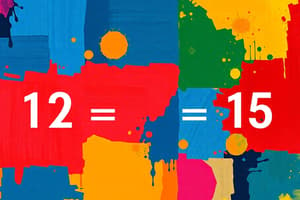Podcast
Questions and Answers
What is the Least Common Multiple (LCM) of 15 and 25?
What is the Least Common Multiple (LCM) of 15 and 25?
- 150
- 5
- 250
- 75 (correct)
The Highest Common Factor (HCF) of two numbers is always greater than or equal to their LCM.
The Highest Common Factor (HCF) of two numbers is always greater than or equal to their LCM.
False (B)
What are the prime factors of 28?
What are the prime factors of 28?
2, 2, 7
According to the multiplication law of indices, $a^m * a^n = a^______$.
According to the multiplication law of indices, $a^m * a^n = a^______$.
Match the index notation expression with its simplified form:
Match the index notation expression with its simplified form:
What is the value of $9^{\frac{1}{2}}$?
What is the value of $9^{\frac{1}{2}}$?
Express the HCF of 24 and 36 using prime factorization method.
Express the HCF of 24 and 36 using prime factorization method.
According to index notation laws, 3 to the power of -2 is equal to -9.
According to index notation laws, 3 to the power of -2 is equal to -9.
Match the following concepts with their definitions:
Match the following concepts with their definitions:
Flashcards
What is LCM?
What is LCM?
Smallest positive integer divisible by all given numbers.
What is HCF?
What is HCF?
Largest positive integer that divides each of the integers.
Prime Factors
Prime Factors
Prime numbers that divide a given number exactly.
Multiplication Law (Indices)
Multiplication Law (Indices)
Signup and view all the flashcards
Division Law (Indices)
Division Law (Indices)
Signup and view all the flashcards
Power Law (Indices)
Power Law (Indices)
Signup and view all the flashcards
Zero Index Law
Zero Index Law
Signup and view all the flashcards
HCF via Prime Factorization
HCF via Prime Factorization
Signup and view all the flashcards
Study Notes
- LCM stands for Least Common Multiple
- LCM represents the smallest positive integer divisible by all specified numbers
- Listing multiples of each number until a common one is found determines the LCM
- Prime factorization offers another method for LCM calculation
- HCF means Highest Common Factor
- HCF denotes the largest positive integer dividing each of the given integers
- Listing factors of each number to find the largest common one calculates the HCF
- Prime factorization can also determine the HCF
Prime Factors
- Prime factors include the prime numbers dividing a given number exactly
- Every integer above 1 is uniquely expressible as a product of prime numbers
- Finding prime factors involves dividing the number by the smallest prime number that divides it exactly then repeating the process for the quotient
- Factor trees are useful in finding prime factors
- The prime factors of 12 are 2, 2, and 3 as an example
Index Notation Laws
- Index notation provides a way to write repeated multiplication of the same number
- A number in index notation is a base raised to a power, also known as an index
- The expression 2 x 2 x 2 converts to 2^3 in index notation
Multiplication Law
- When multiplying numbers sharing the same base, add the indices
- This is represented as a^m * a^n = a^(m+n)
- For example, 2^2 * 2^3 = 2^(2+3) = 2^5 = 32
Division Law
- When dividing numbers with identical bases, subtract the indices
- The formula is a^m / a^n = a^(m-n)
- For example, 3^5 / 3^2 = 3^(5-2) = 3^3 = 27
Power Law
- When raising a power to another power, multiply the indices
- The formula is (a^m)^n = a^(m*n)
- For example, (2^2)^3 = 2^(2*3) = 2^6 = 64
Zero Index
- Any non-zero number to the power of 0 equals 1
- Expressed as a^0 = 1 (where a ≠ 0)
- For example, 5^0 = 1
Negative Index
- A number to a negative power equals the reciprocal of the number raised to the positive power
- This is shown as a^(-n) = 1 / a^n
- As an example, 2^(-2) = 1 / 2^2 = 1 / 4
Fractional Index
- A number to a fractional power signifies a root
- a^(1/n) equals the nth root of a
- For example, 4^(1/2) equals the square root of 4, which is 2
- a^(m/n) equals the nth root of (a^m), which also equals (nth root of a)^m
- As an example, 8^(2/3) equals the cube root of (8^2), which equals (cube root of 8)^2, which is 2^2 = 4
HCF and LCM using Prime Factorization
- Express each number as a product of its prime factors to find the HCF and LCM
- Multiply the lowest powers of the common prime factors to find the HCF
- Multiply the highest powers of all prime factors present in the numbers to find the LCM
- Example: Finding the HCF and LCM of 12 and 18 involves:
- 12 = 2^2 * 3
- 18 = 2 * 3^2
- HCF = 2^1 * 3^1 = 6
- LCM = 2^2 * 3^2 = 36
Studying That Suits You
Use AI to generate personalized quizzes and flashcards to suit your learning preferences.




